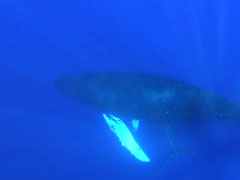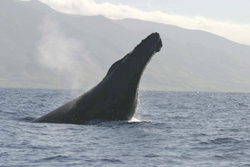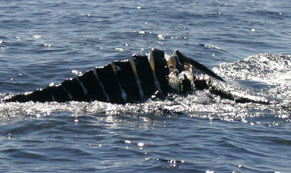Study Findings

We have been able to record social sounds while in the water with various humpback whale pods; pods that vary by gender, behavior, and size (number of animals). Animals in several different behavioral states have been found to make social sounds (i.e. resting pods, traveling pods, surface active pods, competitive groups, and so on) and pods of different sizes have produced social sounds (where the minimum number of individuals is at least two). We have documented calls in mother/calf pod configurations as well. For a typical view of mothers and calves while resting, see the photo to the right; you will see the part of the calf’s body sticking out from below the mother. You can also watch typical mother/calf/escort resting behavior in a video clip. You can hear some of the various social sounds collected by going to the Gallery page.
In addition to being able to catalogue numerous circumstances in which social sound production occurs, we are working on calf underwater behavioral activity budgets. One of the results we are seeing is that humpback whale calves spend a large percentage of their time (more than half when the mother is resting) a few feet under the water surface.  In other words, at a location where they not visible to boaters. This can have devastating results, as you can see from the photograph below showing the back and tail of an injured calf. This calf was photographed in 2005 both above and below the water. It had trailing flesh and enormous gashes from a boat propeller. It is not known if it survived.
In other words, at a location where they not visible to boaters. This can have devastating results, as you can see from the photograph below showing the back and tail of an injured calf. This calf was photographed in 2005 both above and below the water. It had trailing flesh and enormous gashes from a boat propeller. It is not known if it survived.
Summary statistics for social sounds are being analyzed. Sounds are characterized by frequency, duration, and if the signals are amplitude modulated, frequency modulated tonal signals, pulsed signals, etc.
For more information on Photo-ID results obtained in the course of our research, see the Photo-ID Results page.

You can see a summary of our results by opening our presentation. This poster was presented at the December 2005 Society of Marine Mammalogy Biennial Conference in San Diego. In addition to the findings presented in this poster, our preliminary results suggest a difference in behaviors and/ or vocal patterns from pods found in the waters off different Hawaiian islands.
